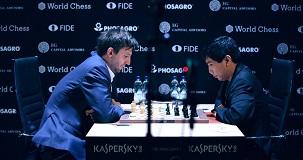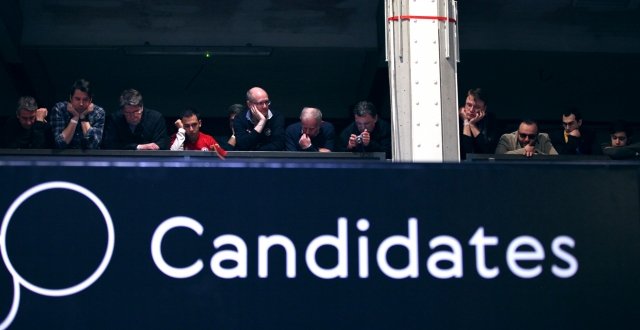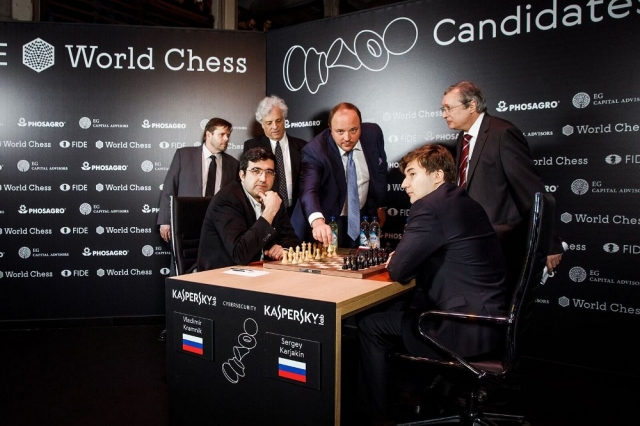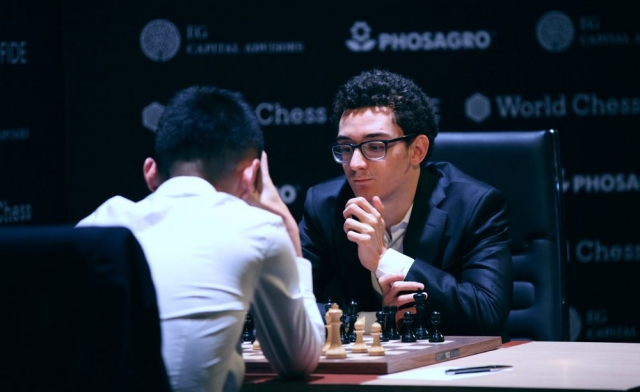Round 2: More Fierce Fights on Day 2 of Candidates Chess Tournament in Berlin

Round 2: More Fierce Fights on Day 2 of Candidates Chess Tournament in Berlin
Round 2 of the 2018 Candidates tournament in Berlin was not nearly as explosive as Round 1, which featured three decisive results, but it was equally hard fought as two of the four games went past five hours before they ended in draws. Alexander Grischuk of Russia recorded the sole victory, beating Wesley So of the United States, who has now lost both his games.
It is still early in the tournament – there will be 14 rounds – but three players, Fabiano Caruana of the United States, Shakhriyar Mamedyarov of Azerbaijan and Vladimir Kramnik of Russia, have to be fairly satisfied with their starts as they are tied for the lead with 1.5 points each.

The Candidates is being organized by World Chess, the commercial partner of the World Chess Federation (FIDE), the game’s governing body. The prize fund is 420,000 euros. The winner will receive 95,000 euros, but, more importantly, he will earn the right to play Magnus Carlsen, the world champion, for the title in the Championship Match in London this November.
In addition to Caruana, Mamedyarov, Kramnik, Grischuk and So, the other competitors are Levon Aronian of Armenia, Ding Liren of China and Sergey Karjakin of Russia. The tournament is a double round-robin, with each player facing all the other competitors twice, once with each color.
The venue for the tournament is Kühlhaus (or “cool house” in English), an industrial building in central Berlin that was built in the early 20th century as a cold-storage facility for fresh produce. Among the principal sponsors of the tournament are PhosAgro, a giant Russian fertilizer company; Kaspersky Lab, a global cybersecurity firm; E.G. Capital Advisors, an investment management company; S.T. Dupont, a global luxury goods maker; Prytek, a venture capital firm; and Isklar, a Norwegian mineral water company.

Andrey Guryev, the chief executive of PhosAgro and Vice-president of the Russian chess federation, made the first symbolic move for Round 2 in the game Kramnik-Karjakin.
Grischuk and So were both looking to bounce back after losing in Round 1. Unfortunately for So, he had the misfortune of playing Black for the second time in a row. The opening was a Ruy Lopez, with Grischuk employing an anti-Marshall system (6 d3). So got a decent position, but instead of playing slowly and patiently, he lashed out with the double-edged move 12 … d5. The resulting position is exactly the sort that Grischuk prefers. Though So was still fine, he had to play precisely and did not manage to do that. Grischuk managed to create dangerous threats on the kingside and So misplayed the defense. He eventually jettisoned a piece to stave off mate. The only reason he did not resign sooner was that Grischuk, as is typical for him, was in tremendous time pressure. But Grischuk survived to the first time control with his material edge intact and even retained his initiative. So resigned on Move 44.
The game between Mamedyarov, who had White, and Aronian was a rather quick draw, brought about by a repetition of moves. For Aronian, it was the same result as in Round 1 against Ding, which has to be a little unsatisfying for him. Though Mamedyarov did not make the best use of having White, a day after netting a point against Karjakin in the longest game of the day, a fast draw may have been a welcome respite. The Candidates is a marathon, not a sprint, and conserving energy can be crucial.
The game between Kramnik and Karjakin involved an opening that has become synonymous with Berlin: the Berlin Defense, which is also known as the Berlin Wall after the Cold War barrier that divided the city for 30 years. Kramnik is associated with the defense more than any other current player because he used it successfully to wrest the world championship title from Garry Kasparov in their 2000 match. Since then, all the top players have added it to their arsenal as Black. In this game, it was employed by Karjakin. That might seem like a nervy thing to do, but the defense suits Karjakin’s style and he has become an expert at it, even using it in Games 3, 10 and 12 of his world championship match against Magnus Carlsen in 2016. The defense is tough to crack, even for Kramnik, and White did not establish any kind of advantage out of the opening. After a series of exchanges, Black was up a pawn, but there were opposite-colored bishops on the board (which often leads to draws) and Black’s rooks were too passive to create any problems for White. After a lot of maneuvering and a few tense moments, a draw was the unsurprising result.

The other game was between Ding and Caruana. Caruana, who was Black, employed a known exchange sacrifice arising out of a Catalan. It was clearly part of his pre-tournament preparation and he got a pawn and excellent compensation. Ding actually had to play carefully because of the weaknesses of the white squares around his king. But he proved up to the task and after 46 moves, the players agreed to a draw as neither had a realistic possibility of making any progress.
Game 3 is Monday at 3 PM, local Berlin time. It can be watched live at Worldchess.com, the official site of the World Championship.
Round 2 Photo Gallery

